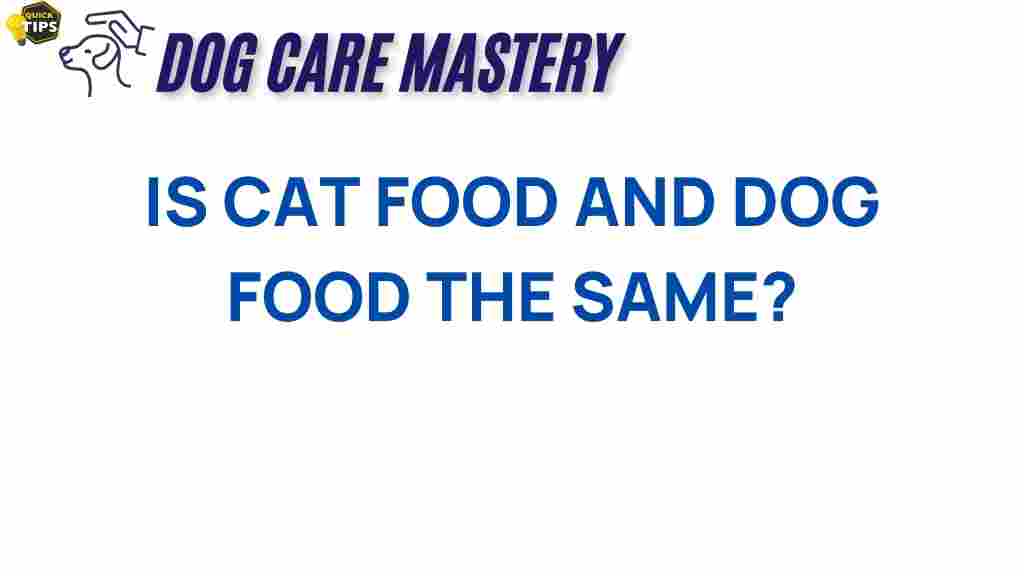Is Cat Food Truly the Same as Dog Food? Understanding Cat Food
When it comes to feeding our beloved pets, one of the most frequently asked questions is: “Is cat food truly the same as dog food?” While it might seem convenient to share food between our furry companions, the truth is much more complex. In this article, we’ll unravel the myths surrounding cat food and dog food, explore their nutritional differences, and help you make informed decisions for your pets’ dietary needs.
The Nutritional Needs of Cats and Dogs
Before diving into the specifics of cat food, it’s essential to understand the fundamental differences in the nutritional requirements of cats and dogs. Both animals are mammals, but their dietary needs vary significantly.
- Carnivorous vs. Omnivorous: Cats are obligate carnivores, meaning they require a diet primarily composed of meat. Dogs, on the other hand, are omnivores and can thrive on a more varied diet that includes both animal and plant sources.
- Amino Acids: Cats need specific amino acids like taurine, which is crucial for heart health, vision, and reproduction. Dogs can produce taurine in their bodies and do not require it in their diet.
- Fatty Acids: The types of fatty acids required also differ. Cats require arachidonic acid, while dogs can synthesize it from plant sources.
Ingredients: What’s in Cat Food?
Cat food is meticulously formulated to meet the unique dietary needs of felines. Here are some common ingredients found in high-quality cat food:
- Protein Sources: Chicken, turkey, fish, and beef are common protein sources in cat food.
- Vitamins and Minerals: Essential nutrients are added to ensure a balanced diet, including vitamins A, D, E, and B vitamins.
- Taurine: As mentioned earlier, this amino acid is often added to cat food to support heart and eye health.
- Carbohydrates: While cats have a limited ability to digest carbohydrates, some cat foods contain grains or vegetables for energy.
Why Dog Food Isn’t Suitable for Cats
Now that we know what’s in cat food, let’s explore why dog food isn’t suitable for cats. Here are some critical points to consider:
- Lack of Essential Nutrients: Dog food does not contain enough protein or the right balance of amino acids required by cats.
- Inadequate Vitamins: Dog food lacks certain vitamins and minerals that are essential for cats, like taurine and vitamin A.
- Unbalanced Fatty Acids: The types of fats in dog food are often not suitable for cats, who have different metabolic needs.
Comparing Cat Food and Dog Food: A Breakdown
To further clarify the differences, let’s take a closer look at the nutritional breakdown of cat food versus dog food.
| Nutrient | Cat Food | Dog Food |
|---|---|---|
| Protein | 30-50% | 18-25% |
| Fat | 15-30% | 8-15% |
| Carbohydrates | Minimal | 30-60% |
| Taurine | Essential | Not required |
Common Myths About Cat Food
As with any topic, myths abound regarding cat food and dog food. Here are some common misconceptions:
- Myth 1: “Cats can eat dog food occasionally.”
This is not true, as even occasional consumption can lead to nutritional deficiencies. - Myth 2: “All pet food is created equal.”
Not all brands or formulations provide the same quality of nutrition. - Myth 3: “Homemade diets are better.”
While some owners prefer homemade meals, it’s crucial to ensure these diets are balanced and meet all nutritional needs. Consulting a veterinarian is recommended.
Choosing the Right Cat Food
When selecting cat food, considering your cat’s specific needs is vital. Here are some tips for choosing the best cat food:
- Age and Lifestyle: Kittens, adults, and senior cats have different nutritional requirements.
- Health Conditions: If your cat has specific health issues, consult your veterinarian for specialized diets.
- Quality Ingredients: Look for cat food with high-quality protein sources and minimal fillers.
How to Transition Between Cat Foods
Transitioning your cat to a new food should be a gradual process to avoid digestive upset. Here’s a step-by-step guide:
- Days 1-2: Mix 25% of the new cat food with 75% of the old food.
- Days 3-4: Increase the new food to 50%, mixing it with 50% old food.
- Days 5-6: Mix 75% new food with 25% old food.
- Day 7: Serve 100% new food.
Troubleshooting Tips for Cat Food Issues
If you encounter issues while feeding your cat, here are some troubleshooting tips:
- Refusal to Eat: If your cat is refusing to eat, try warming the food slightly or offering different textures (wet vs. dry).
- Digestive Upset: If your cat experiences vomiting or diarrhea, consult your veterinarian and consider a slower transition.
- Weight Management: If weight gain is a concern, look for weight management formulas or consult your vet for a tailored diet plan.
Conclusion: Understanding the Importance of Cat Food
In conclusion, cat food and dog food are not interchangeable. Each type of food is formulated to meet the specific dietary requirements of the respective animal. Understanding these differences is crucial for your pet’s health and well-being. Always consult a veterinarian if you’re unsure about your pet’s dietary needs or if you’re considering making significant changes to their diet.
For more information on pet nutrition, visit this resource. Remember, the right food can make all the difference in your pet’s health and happiness!
If you’re looking for more tips on pet care, feel free to check our blog for a wealth of information!
This article is in the category Nutrition and created by dogcaremastery Team
